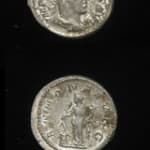Silver Antoninianus of Emperor Philip I the Arab, 244 CE - 249 CE
Silver
C.7663
Obverse: IMP M IVL PHILIPPVS AVG; Radiate, Draped, and Cuirassed Bust of the Emperor Facing Righ Reverse: ANNONA AVGG; Annona, Standing to the Left, Holding Ears of Grain over a...
Obverse: IMP M IVL PHILIPPVS AVG; Radiate, Draped, and Cuirassed Bust of the Emperor Facing Righ
Reverse: ANNONA AVGG; Annona, Standing to the Left, Holding Ears of Grain over a Modius and a Cornucopiae
The reign of Marcus Julius Philippus, Philip I, (nicknamed "the Arab" after the origin of his family) is clouded in history by the way it began. As Praetorian Prefect to Gordian III, Philip may have been instrumental in the murder of the young Emperor. Already in practical control of the Empire, Philip was the obvious choice to succeed. What little history of the period that survives indicates he was a good ruler who faced many challenges successfully. Like Septimius Severus nearly 50 years earlier, Philip was a family man with certain desires to establish a dynasty. Soon after his own elevation he named his wife (Otacilia Severa) Augusta and his son (Philip II) Caesar. After a very few years, again following the model of Septimius, Phillip II was made Augustus and placed even with his father to insure his eventual succession.
How many hands have touched a coin in your pocket or your purse? What eras and lands have the coin traversed on its journey into our possession? As we reach into our pockets to pull out some change, we rarely hesitate to think of who touched the coin before us, or where the coin will venture to after us. More than money, coins are a symbol of the state that struck them, of a specific time and place, whether currency in the age we live or an artifact of a long forgotten empire. This stunning hand-struck coin reveals an expertise of craftsmanship and intricate sculptural detail that is often lacking in contemporary machine-made currencies. This coin is more than an artifact; it is a shining vestige of an ancient Emperor passed from the hands of civilization to civilization, from generation to generation.
Reverse: ANNONA AVGG; Annona, Standing to the Left, Holding Ears of Grain over a Modius and a Cornucopiae
The reign of Marcus Julius Philippus, Philip I, (nicknamed "the Arab" after the origin of his family) is clouded in history by the way it began. As Praetorian Prefect to Gordian III, Philip may have been instrumental in the murder of the young Emperor. Already in practical control of the Empire, Philip was the obvious choice to succeed. What little history of the period that survives indicates he was a good ruler who faced many challenges successfully. Like Septimius Severus nearly 50 years earlier, Philip was a family man with certain desires to establish a dynasty. Soon after his own elevation he named his wife (Otacilia Severa) Augusta and his son (Philip II) Caesar. After a very few years, again following the model of Septimius, Phillip II was made Augustus and placed even with his father to insure his eventual succession.
How many hands have touched a coin in your pocket or your purse? What eras and lands have the coin traversed on its journey into our possession? As we reach into our pockets to pull out some change, we rarely hesitate to think of who touched the coin before us, or where the coin will venture to after us. More than money, coins are a symbol of the state that struck them, of a specific time and place, whether currency in the age we live or an artifact of a long forgotten empire. This stunning hand-struck coin reveals an expertise of craftsmanship and intricate sculptural detail that is often lacking in contemporary machine-made currencies. This coin is more than an artifact; it is a shining vestige of an ancient Emperor passed from the hands of civilization to civilization, from generation to generation.



